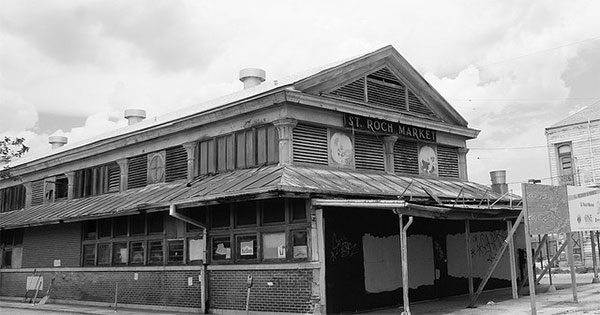
Early in the morning on May 1, a crew of ninja-commando-vandals—apparently three men and two women, wearing black outfits and black balaclavas—attacked the St. Roch Market on St. Claude Avenue.
You can watch it all unfold on fairly high-res video from the security cameras. The crew moves in stealthily, as if rehearsed, using Super Soaker-type sprayers dipped into buckets of pink and blue paint to splatter the building. One of the commandos spray paints, “Yuppy = Bad.” Another uses a hammer to damage 18 hurricane-proofed windows. The most dramatic moment occurs when one of the attackers looks up at the security camera, then sends a stream of pink paint blasting toward it.
Some backstory. The handsome Greek Revival marketplace was built in 1875 as one of a network of city-owned public markets. (New Orleans once operated 34 neighborhood markets, more than any other city in America.) Until Katrina, it was still a place to buy seafood by the pound, along with poboys. The tenant didn’t return after the storm, and the city more or less let the building rot and become graffiti-scarred. Eventually, the city solicited ideas and selected a team to restore and manage it, and last month, the market reopened.
The project, which cost $3.7 million, has been controversial—some neighborhood residents have groused that what they needed most (and had been promised in meetings) was a place offering affordable groceries. What they got was a high-end food court, one of a genre that’s been cropping up nationwide (“Eataly-style food halls” The New York Times has called them). Though a modest produce stand exists just inside the front door, the market attracts far more visitors to its dozen vendors selling crepes, fresh oysters, West African street food, and “Creole meets Korean” fare. You can also buy hand-crafted vinegar and artisanal grits.
It’s as yet unknown who was behind the vandalism. (If it were up to me, I’d subpoena Netflix records and look for any New Orleanian who recently watched Wes Anderson’s first film, Bottle Rocket.) The speculation on online forums is that it wasn’t orchestrated by longtime neighborhood residents who resented the broken promises. Rather, that more recent arrivals to the city are to blame.
Some of the evidence marshaled included the use (and spelling) of the word “yuppy,” which you don’t hear much locally (or since the 1980s for that matter). The more telling clue was a video screenshot of one of the women commandos, who revealed a lower back tattoo depicting cello f-holes when she bent over to refill her paint gun.
Such tattoos are so common as to be hopelessly clichéd—so, good luck canvassing local tattoo shops for leads. They’re also tied to a famous Man Ray photo of a woman’s cello-shaped naked back superimposed with sound holes. It just may be that New Orleans is facing an invasion of well-educated East Coast anarcho-Dadaists.
But, assuming the vandals are caught, I’m guessing they’ll turn out to be a super-motivated subset of a group that Tulane geographer Richard Campanella has called super-natives. In a widely discussed 2013 essay about the city’s gentrification in New Geography, Campanella spoke of transplants who “arrive endeavoring to be a part of the epic adventure of living here; thus, through the process of self-selection, they tend to be Orleaneophilic ‘super-natives.’” That is, they’re devotees of second lines and raggy jazz, they loudly defend the city’s Caribbeanish laissez-faire attitude, they resist creeping gentrification by any means—though with their tidy cello tattoos, it seems pretty likely they’re also part of it.
Campanella identified four groups of immigrants who typically arrive in sequence in areas with desirable (if decrepit) historic homes: “gutter punks” who squat; hipsters who rent; bohos who buy and renovate; and then the bonafide gentry, who give the process its name. The self-styled defenders of the St. Roch neighborhood, fighting against the encroachments of the upscale market and its well-heeled clientele, probably belong to one of the first two categories, and have decided to declare war against the latter two.
So what it comes down to is this: subsets of invasive species battling for a formerly ignored ecological niche. How will this affect native New Orleanians and the city’s long-term development? Stay tuned for next season’s episodes.

